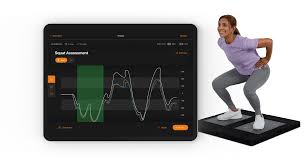20 Dec Using force plates in injury management
 Force plates have been used for many years in research and with elite athletes. However, more recently they have become more accessible, and are now being used in general practice for injury management and rehab.
Force plates have been used for many years in research and with elite athletes. However, more recently they have become more accessible, and are now being used in general practice for injury management and rehab.
So, what is a force plate and how may it help with my recovery?
A force plate is like an advanced set of scales which measures the forces(weight) that you transmit into the ground. Unlike a set of scales which largely measures from the middle of the plate, it takes measurements from all four corners. This enables it to track any movement happening both forwards and sideways, as well as up and down. It also gives continuous measurements, many times a second, rather than the one-off result you get from a set of scales. This means we can see changes over a period of time, both short and long term. They are often used in pairs, so you can see what is happening to both the left and right side separately.
So how might this work in practice?
- Balance – falls risk.
We know that people with reduced balance have an increased falls risk. If we can identify those with poor balance, we can give them a program of exercises to help reduce their risk of falling.
When you are standing balanced you are not actually still. Your body drifts forwards and backwards and side to side. However, if your balance is good then this is a tiny movement as the body is quickly noticing this sway and adjusting for it.
The force plate, with its corner measurement system, tracks this movement and records both how quick you react, as well as how far you move before your body responds. This not only gives us a measurement of how good your balance is now, so how big your falls risk is, but these can be compared with later measurements to make sure any exercise program is working.
- Tracking recovery progress.
The force plates indirectly measure your strength, as they record how much force you are putting through them. Either by measuring the left and right sides separately, or looking at measurements using two plates, you can compare how one side is doing compared to the other, as well as tracking progress of the injured side over time. They can also tell us how well you are using the strength you have. Think of the difference between someone who needs strength like a shot putter – all at once – compared to some one who may need the same strength, but not in such a short time frame – someone lifting a heavy weight.
- Are you ready / recovered fully?
There are different ways of measuring strength. We, as a therapist, can push against you. This can tell us your muscles are working well, but this is better for picking up weakness than assessing strength. There are also measuring tools called dynamometers. These give us a figure of how hard you can push, which can be compared to the other side. Finally, we could test you in the gym and see how much you can lift on one side compared to the other.
What these tools don’t do is tell us how well you are moving. A force plate, recording measures multiple times a second, will show us if you are favouring one side over the other, either by habit or by a change in muscle function. This change could mean more stress is going through the recovering region, risking further damage or a more prolonged recovery. Alternatively, it could mean that you are avoiding using the injured side which could stress your ‘good’ side.
- Repeated niggles
Sometimes you just have an ongoing niggle or repeated injuries in the same body region. These often can be hard to diagnose as it may only come on after, for example, running 10km. When you get assessed in the clinic there is often nothing much to find.
In this case, looking at some different movements on a force plate may show some changes in your movement, which aren’t obvious visually when assessing in the clinic. This may then lead to a new management strategy to help your problem.
Force plates are a tool that can help your therapist understand better where you are in your recovery. In some situations, they can also help identify an increased injury risk. Though they may not be needed in every rehab program, they are a especially useful tool to help in the difficult or longer term injury.
For any further information on force plates feel free to talk to one of our physiotherapists.


Sorry, the comment form is closed at this time.